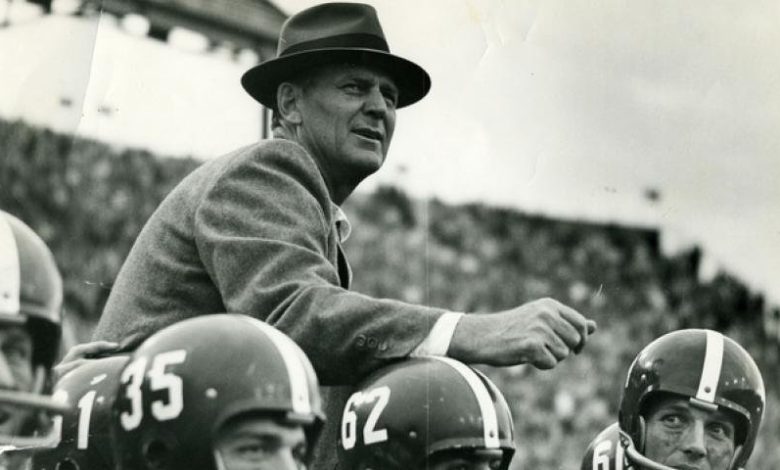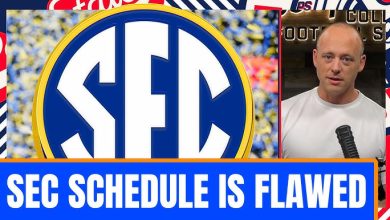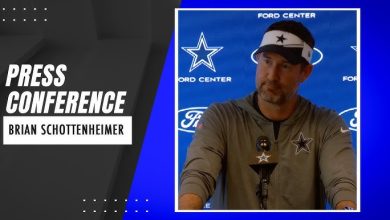Bear Bryant is considered by many to be one of the greatest college football coaches of all time, and best known as the head coach of the University of Alabama football team, the Alabama Crimson Tide, from 1958 to 1982. During his 25-year tenure as Alabama’s head coach, he amassed six national championships and 13 conference championships.

Paul William “Bear” Bryant is a name etched into the annals of American sports history, revered not only for his unmatched success as a college football coach but also for the indelible mark he left on the culture of the sport. Born on September 11, 1913, in Moro Bottom, Arkansas, Bryant’s journey from humble beginnings to becoming one of the most legendary figures in college football is a tale of determination, leadership, and transformation. Best known for his 25-year tenure as the head coach of the University of Alabama Crimson Tide, from 1958 to 1982, Bryant’s era was one of unparalleled dominance, where he amassed six national championships and thirteen conference titles, building a legacy that transcended the gridiron.
Bryant’s early years foreshadowed the toughness and resilience that would later become synonymous with his coaching style. He earned his famous nickname, “Bear,” at the age of 13 after agreeing to wrestle a captive bear during a traveling carnival show in his hometown. Although the match left him battered and bruised, it revealed a fearless spirit that would define his character. His football journey began at Fordyce High School in Arkansas and continued at the University of Alabama, where he played as an end from 1933 to 1935. Bryant was part of Alabama’s 1934 national championship team, and it was here that his passion for football solidified.
After graduating, Bryant began his coaching career as an assistant at various universities, including Alabama, Vanderbilt, and Georgia, before earning his first head coaching job at the University of Maryland in 1945. His tenure there was brief but marked by a strong sense of discipline, as evidenced by his decision to suspend a star player for breaking team rules—a move that cost him his job after just one season. From Maryland, he moved on to the University of Kentucky, where he led the Wildcats to their first and only Southeastern Conference (SEC) championship in 1950. Despite his success at Kentucky, Bryant often found himself overshadowed by the school’s basketball program, leading to frustration and eventual departure.
In 1954, he took the head coaching job at Texas A&M University, where he inherited a struggling program. His infamous “Junction Boys” training camp in the brutal Texas heat of Junction became a symbol of his unrelenting drive for toughness and excellence. The grueling conditions tested players to their physical and mental limits, and though many quit, those who remained formed the core of a revitalized team. By 1956, Texas A&M was a competitive force, and Bryant’s star was on the rise.
In 1958, Bryant returned to Alabama as head coach, and it was there that his legend was truly born. The Crimson Tide was a floundering program when he arrived, but Bryant vowed to make Alabama a winner again. He often said, “Mama called, and when Mama calls, you just have to come running.” Within a few years, Alabama was once again a powerhouse. By 1961, in only his fourth season, Bryant led the Tide to an undefeated season and a national championship. This marked the beginning of a dominant era that would span over two decades.
Bryant’s coaching philosophy was rooted in discipline, hard work, and mental toughness. He believed in preparing his players not just for football but for life. His practices were notoriously intense, and he was a master motivator who knew how to bring out the best in his athletes. While he was feared and respected, he was also deeply admired. Many of his former players credit him with shaping their character and teaching them invaluable life lessons. His teams played with a physical style that reflected his own rugged persona, and they were almost always fundamentally sound and well-prepared.
One of Bryant’s most significant contributions to college football was his role in integrating the sport in the South. Though initially slow to embrace integration, Bryant recognized the need for change in the late 1960s and early 1970s. At a time when racial tensions were high and many Southern schools resisted integration, Bryant began recruiting Black athletes, understanding that to remain competitive at the highest levels, talent had to come before tradition. In 1971, Wilbur Jackson became the first Black scholarship player at Alabama, and John Mitchell became the first Black player to take the field. Bryant’s efforts helped pave the way for broader integration in the SEC and earned him respect for his quiet but determined leadership on this front.
Throughout the 1960s and 1970s, Bryant’s Alabama teams were dominant, winning national championships in 1961, 1964, 1965, 1973, 1978, and 1979. His teams were known for their powerful running games, disciplined defenses, and relentless pursuit of excellence. He adapted his coaching strategies over time, including a notable shift to the wishbone offense in the 1970s, which reinvigorated the team and led to another wave of championships. His ability to evolve with the game was one of his greatest strengths, demonstrating not only his football acumen but also his willingness to learn and change.
Bryant’s success was not just measured in wins and titles but also in his ability to build a program that stood as a model of consistency and excellence. Under his leadership, Alabama became synonymous with winning, and Bryant himself became an icon. Clad in his signature houndstooth hat and leaning against the goalpost before games, he was a larger-than-life figure whose presence alone inspired awe. His speeches and sayings became legendary, offering wisdom on football, leadership, and life. Quotes like “It’s not the will to win that matters—everyone has that. It’s the will to prepare to win that matters,” encapsulated his philosophy and continue to resonate today.
Despite his fierce competitiveness, Bryant was known for his deep loyalty and personal connections with his players. He maintained contact with many of them long after they had left Alabama, offering advice and support. His commitment to their development as men was just as important to him as their performance on the field. This loyalty was often reciprocated, as former players spoke of the profound impact he had on their lives. His ability to inspire unwavering dedication and effort was a hallmark of his leadership.
In 1981, Bryant surpassed Amos Alonzo Stagg as college football’s all-time winningest coach, a record that stood for years. He retired after the 1982 season with an astonishing 323 career victories, a record of 323–85–17, and the admiration of an entire nation. His final game, a victory in the Liberty Bowl over Illinois, was a fitting capstone to a career defined by excellence. Just weeks after retiring, Bryant passed away on January 26, 1983, at the age of 69. His death was met with an outpouring of grief from the football community and beyond. Thousands attended his funeral, and his passing marked the end of an era.
Bear Bryant’s influence on college football is immeasurable. He helped shape the SEC into the powerhouse conference it is today and set a standard of success that few have matched. His legacy lives on at the University of Alabama, where his name is revered and his statue stands outside Bryant–Denny Stadium, a lasting tribute to his greatness. His name is also honored through the Paul “Bear” Bryant Award, given annually to the nation’s top college football coach.
Beyond the wins, titles, and accolades, Bryant’s legacy is defined by his impact on the countless lives he touched and the values he instilled. He was a coach, a mentor, a leader, and an icon. His story is not just one of football triumphs but also of resilience, transformation, and the enduring power of leadership. Bear Bryant didn’t just build a football program—he built a dynasty, and in doing so, he became a legend whose influence still echoes through the sport more than four decades after his final game. His life is a testament to the power of vision, perseverance, and the belief that greatness is achieved not only through talent, but through heart, discipline, and the relentless pursuit of excellence.









